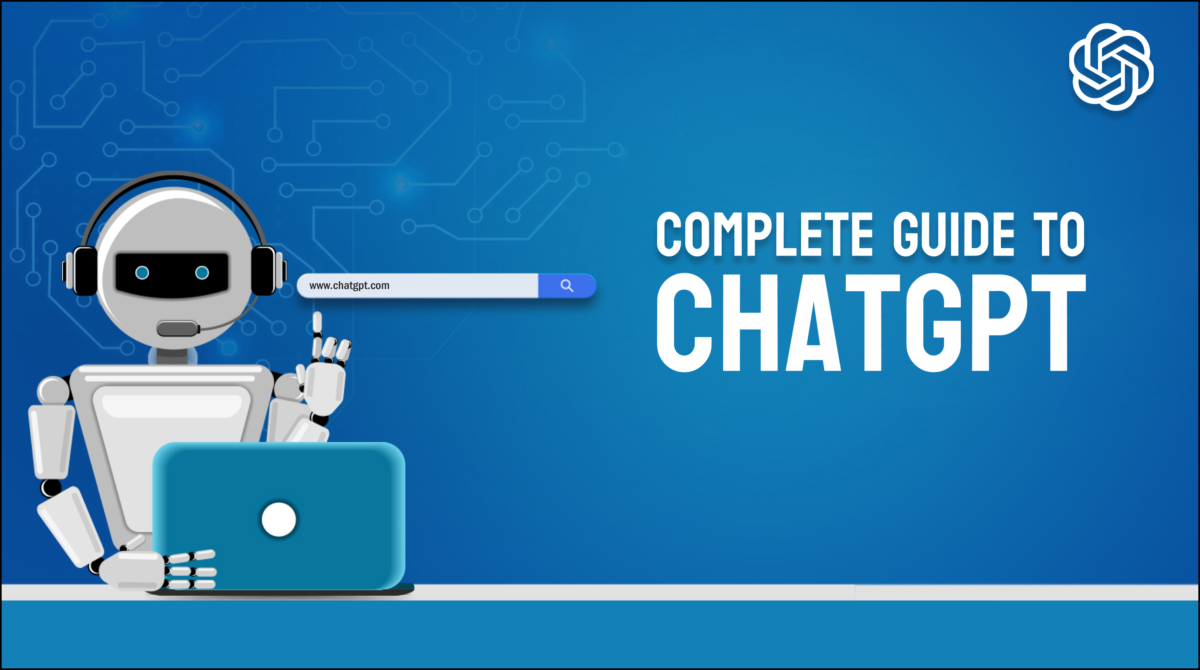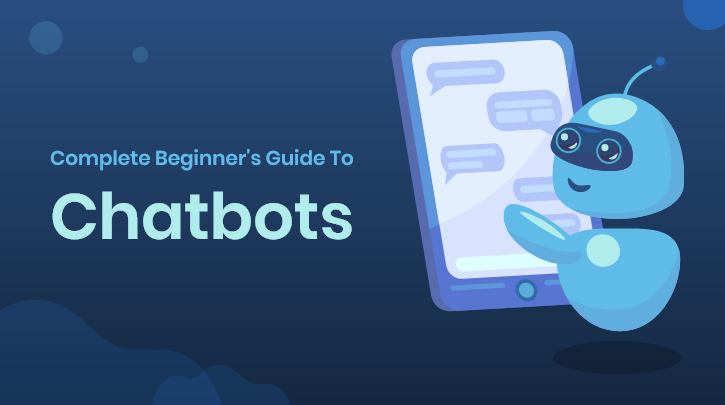
The Ultimate Guide to Chatbot Technology for Non-Technical Owners
In times when stepping outside was a mortal risk, many businesses worried about being unable to reach their customers properly. But chatbots came up as a solution which saved time, money and enabled automated customer service. Chatbots have enabled businesses to provide 24/7 customer support. More and more businesses are adopting these bots to generate leads, or solve queries.
A chatbot uses artificial intelligence to impersonate humans and update itself to provide better results. This blog is going to help you understand everything about chatbots- from what they are to how they are developed. Read on to find out what chatbots actually are.
What Is a Chatbot?
A chatbot is a software made using AI to impersonate humans in text-based conversations. They interpret and process the user’s words to provide a pre-set answer.
Businesses use chatbots to effectively address and solve customer’s queries. This allows a business to save extra costs and enables automated lead generation and custom support.
How Does It Work?
Chatbots are built using either Natural processing language or Machine Learning. Though they look like a messaging application, there is a deep application layer, database, and APIs working behind the scenes.
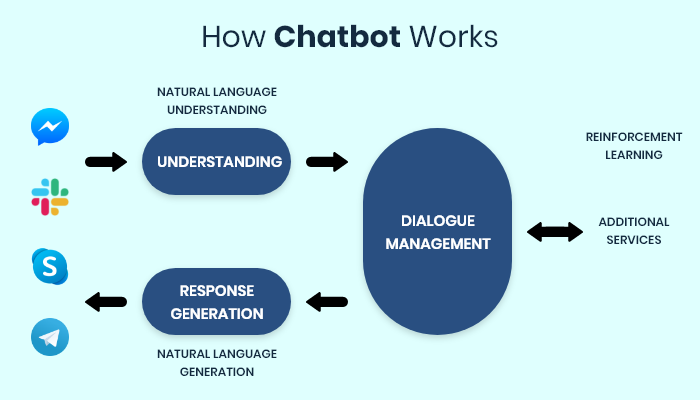
When a chatbot receives a query from the user, it processes the text to understand what it means. Once it has processed the input, it starts working on the output. A rule-based chatbot has fixed answers for anticipated questions. When it matches the input with the questions in its database, it sends the appropriate answer back to the user.
In AI-Chatbot, the working is just a bit different. It constantly collects data to provide better service to the customers. This way it can even change answers to provide personalized results. Sounds very interesting, right? Read on to learn more about chatbot technology.
Types of Chatbots Technology
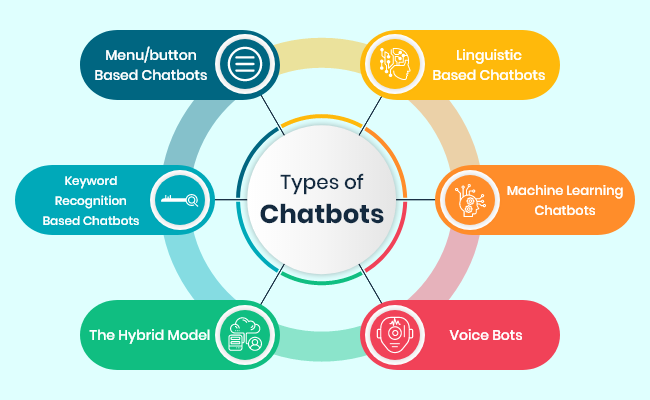
Chatbots can be categorized into two types-
1. Rule-based Chatbots
Rule-based chatbots use a series of defined rules. These rules are based on the types of problems that the chatbot is going to solve. These rules have an if/then based flow chart structure. The chatbot developers anticipate what the user might ask and work out responses accordingly.
If a query is made outside of the defined rules, a rule-based chatbot is unable to respond. These chatbots do not get updated through interactions.
2. AI Chatbots
AI chatbots can simulate conversations with natural language through messaging applications. These chatbots are usually more conversational, data-driven and predictive.
Unlike rule-based chatbots, these do not follow a defined set of rules. AI chatbots use machine language and natural processing language to solve customer’s queries. They collect numerous data while interacting with the users. Later on, this data is used by chatbots to personalize a user experience.
AI chatbots are much more complex than rule-based chatbots. Businesses often have to hire chatbot developers with years of professional experience to build a good AI chatbot.
Benefits of Chatbot for your Business
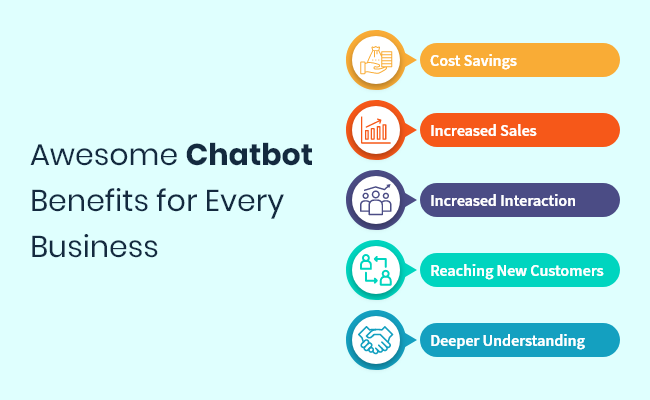
👍 Cost Savings
Implementing a well-functioning chatbot is much cheaper and faster than hiring employees for the same task. Being automated, chatbots can deal with multiple customers at the same time. Using chatbots for customer support cuts down on employee costs and also diminishes the risk of human error.
👍 Increased Sales
Chatbots constantly monitor consumer activity and collect data. By analyzing this data, a business can gain better insights about the customer. This helps in recommending personalized advertisements to the customers. By delivering the best offer at the right time to the customers, the chances of closing a deal increase.
👍 Improved Customer Interaction
Chatbots are available 24/7 for customers. No matter what time it is or how many users are sending inputs, a chatbot is always going to respond in seconds. This has provided better results to both the customers and the business.
👍 Lead Generation
Chatbots have allowed businesses to be active on social media. Being active on social media, the business can reach new potential customers quite easily. Collecting consumer data also allows sending personalized advertisements /suggestions to the customers.
👍 Collecting Data About the Consumer
Chatbots constantly monitor and collect information about the consumer. This enables the chatbot to provide a better and personalized user experience to the customers. This increases the sales for the business by providing consumer data to the user.
Uses of Chatbot
Chatbots can be used in many ways to improve our lives. Businesses in every industry are chatbots to improve their to provide faster service and better user experience to the customers. Given below are some common use cases of chatbots-
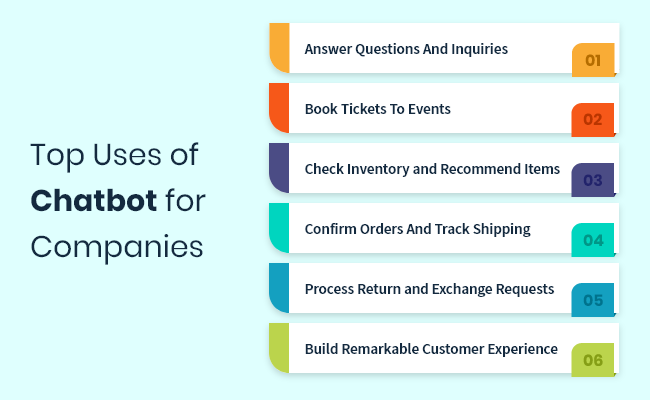
✔ Online Shopping
Finding products that you are searching for can be a hassle while online shopping. Even when you are looking for something specific, it can consume a lot of time. To simplify this issue and make the customer’s shopping experience better, e-commerce businesses have started using bots in their apps.
These bots help customers discover personalized products and find the best deals.
✔ Healthcare Support
Though chatbots were being used in the healthcare industry even before the pandemic, their number has increased drastically post Covid-19. Many chatbots were introduced during Covid-19 to ease people’s anxiety and provide information about the pandemic.
Many bots help people find vaccination centers and medicine. Customers want their problems solved immediately. Getting a late response can harm the customer’s relationship with the business. This is where chatbots help businesses. They provide immediate assistance to the customers, keeping them satisfied and thus improving the relationship between customer and business.
Nowadays most businesses use chatbots to provide customer support.
✔ Sales
Sales have also become a common use case of chatbots. There are many businesses using chatbots to drive sales. These bots are active on social media platforms and share information and interactive content regarding products with the customers.
Top Chat-bot Development Frameworks
Chatbot development technology is becoming progressively popular. There are many chatbot development frameworks available in the market. In this blog, we’ll see the top 5 chatbot development frameworks in 2021. These are-
● Google Dialogflow
Dialogflow is a conversational platform allowing users to design and build chatbots and voice apps. With support for major messaging platforms like Facebook, Whatsapp, Telegram, Skype, etc, it is the most used chatbot development tool.
It supports 20+ languages allowing users experienced in any major programming language to build a chatbot. Dialogflow also provides a REST API to integrate the chatbot with custom conversational interfaces.
● Microsoft Bot Framework
Microsoft Bot Framework has two components – Channel Connectors and BotBuilder SDKs.
Developers can easily use BotBuilder SDKs to develop chatbots and implement business logic into them. It has many code samples and templates for developers to use. Supporting various languages like JavaScript, Python, etc., BotBuilder SDKs come with built-in emulators to debug codes and test conversations.
Once the chatbot is built, channel connectors are used to connect it to a messaging platform.
● Amazon Lex
Amazon Lex is a platform allowing developers to build conversational interfaces using voice and text. It has the flexibility and functionality of natural language understanding and automatic speech recognition. With Amazon Lex, you can build highly engaging interfaces.
With Amazon Lex, developers do not need deep learning expertise to build a chatbot. Developers only need to specify the required conversation flow to the Amazon Lex console. After that, the dialogue and responses are managed accordingly by the console. Developers can then build, test, and publish the text and voice chatbot on messaging platforms.
● BotKit
Botkit is a Node.js-based, open-source chatbot-making tool kit. Developers can use this framework to develop chatbots for major messaging platforms like Facebook, Skype, etc. It provides a lot of tools to developers like Botkit studio, boiler app starter kits, a core library, and various plugins to extend your chatbot.
● Rasa Stack
Rasa Stack is an open-source chatbot development framework with two major components – Rasa NLU and Rasa Core. Rasa Core is a tool for building conversational chatbots. Rasa uses Machine learning to build sophisticated dialogues.
With Rasa Stack, chatbots can be deployed on the developer’s server without losing any of its components. Rasa core supports platforms like Facebook, Slack, Telegram, and Twilio.
Best Languages for Chatbot Development
☛ Python
Python is by far the most popular chatbot development language. The presence of Artificial intelligence markup language makes composing the syntax much easier for developers. The risk of errors also gets reduced when using python for development.
☛ Clojure
Clojure is a form of a programming language called Lisp. It works on a Java Virtual Machine. It allows the developers to compose the application’s code as a series of functions that are straightforward and simple to test.
☛ Java
Java is the language to develop AI chatbots. It offers a simple method for coding complex algorithms. It is the best language for Custom Software Development. It has an inbuilt toolkit and allows Java developers to build interactive user interfaces for their chatbots.
☛ PHP
PHP is an open-source language for chatbot development. It is very easy to utilize and reduces the cost of development. PHP Developers can access numerous libraries with the help of API.
☛ Ruby
This object-oriented programming language is similar to python in regards to writing the syntax. It provides developers with a wide range of libraries that developers can use while developing a chatbot.
How to Develop a Chatbot?
The process of developing a chatbot is very lengthy and time-consuming. It requires proper planning and execution. Let us take a look at all the steps of chatbot development.
Step 1- Identify the Need
Before developing a chatbot, it is important to define why that chatbot is needed. Defining the need for a chatbot is going to help in selecting the type of that chatbot and what business logic should be used in it.
Step 2- Select Channel for Deployment
The next step is selecting the channel on which the chatbot is going to be deployed. Conduct thorough research on your customer’s activity to find the best channel. Deploy the bot on the customer’s most-used channel to get the best results.
Step 3- Choose The Tech-stack
Choosing the right tech stack for development will make the development process faster. To do this, businesses should consult with a Chatbot Development Company.
Step 4- Design the Conversation
The development part of the chatbot includes designing the conversation flow. Developers need to add business logic to it so that the chatbot can respond properly. Many platforms have drag and drop interfaces so even non-technical people can build a chatbot. But if you have chosen a framework, then you need to hire software developers to develop a well-functioning chatbot.
Step 5- Test the Bot
Just like any other application, it is important to test chatbots. Testing it will let the developers check its functionality. If it is functioning properly, then it’ll be sent for deployment. But if it is not responding appropriately then the developer needs to make changes in the codes.
Step 6- Deploy and Maintain
When you are deploying the chatbot, make sure all the endpoints are connected and the bot is connected to the business’ system. After the chatbot is deployed on the channels, constant maintenance is required to update the answers and functionality of the chatbot.
Read Also, How to Manage a Remote Developer For A Project?
Cost of Chatbot Development
Now that you understand how to develop a Chatbot, let’s take a look at how much it is going to cost. There are two ways to develop a chatbot – firstly, you can hire a team of top software developers but it is very costly and time-consuming. Secondly, you can hire a software development services provider company experienced in Chatbot Development. This reduces the extra cost and time required to hire separate developers.
Other than this, the cost of chatbot development depends on the number of features and the type of chatbot you want to build. Developing a basic chatbot with AI can start from $30,000. While developing an ML-driven well-functioning chatbot can cost around $90,000.
Why Are We Best for Chatbot Development?
Chatbots have become an essential part of every business. Chatbot technology is developing constantly and introducing new use cases. Businesses all over the world are integrating chatbots in their daily workings.
If you want to develop a chatbot for your business, then you’ve come to the right place. At Maven Cluster, we build well-functioning chatbots that handle mission-critical tasks. Being a reputed Software Development Company In India, Maven Cluster has helped many businesses to yield higher ROIs.
Our developers help businesses with creating the best strategy to fully utilize their chatbots. We evaluate the business logic and then plan out the development process. Automate your business using chatbots, by hiring our software development services. Contact our experts to get a free consultation and discuss your chatbot strategy.


